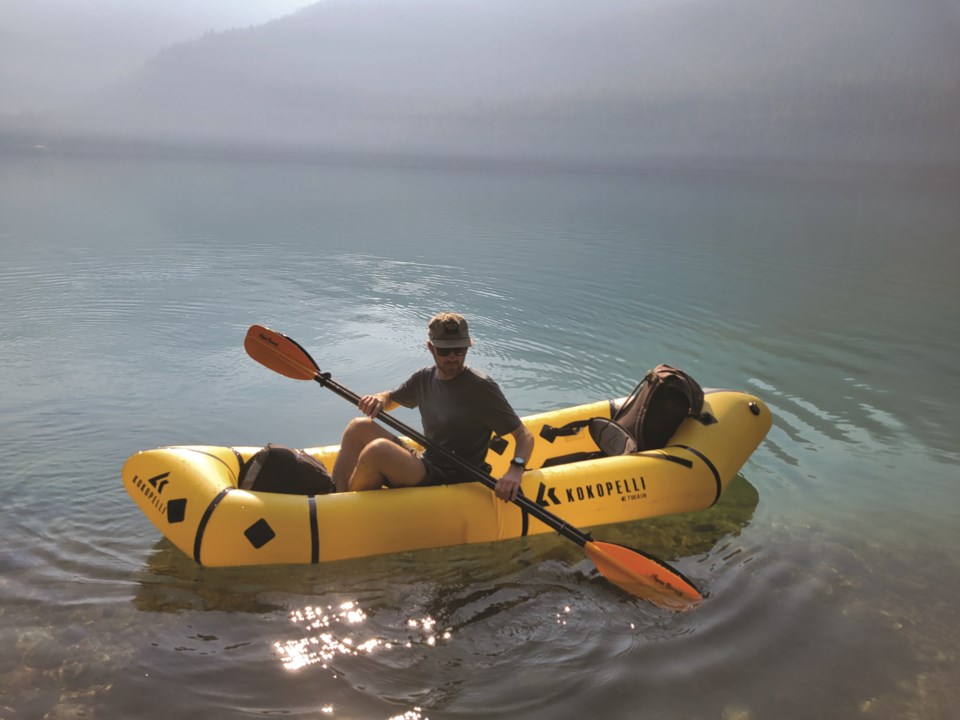A recurring theme I’ve had in this column is how one can maximize their outdoor experience by gaining distance from crowds. After all, the backcountry of British Columbia is about connecting to the mountainous landscape, not vibing with hundreds of other people like at a music festival.
There are a few traditional ways you can avoid crowds at popular backcountry destinations. Getting up in the wee dark hours and being first on the trail is one way. Opting for an occupation that allows days off mid-week is another. But as I’m sure you’ve noticed, these traditional techniques have also picked up in popularity as everyone vies for their own bit of backcountry solitude.
The next step involves some investment. A four-by-four vehicle with ample ground clearance unlocks B.C.’s vast network of logging roads, letting you burn right past the Evo carshares that litter parking pullouts metres from the highway. A snowmobile unlocks the same logging roads in the winter, allowing an express ride to backcountry ski zones not yet overwhelmed by members of the South Coast Touring Facebook group. If you are lucky enough to have friends with access to sailboats or fixed-wing aircraft, the possibilities really do become endless.
I’ve invested in the truck and snowmobile, and believe both spends to be very much worth it. The map of places I can now access within an hour’s drive of my house has probably quadrupled in size, not unlike progressing in an open-world video game. But my partner and I were curious about how else we could make the most of backcountry zones close to home, ones we’ve more or less given up on given the weekend crowds. The answer came with a unique piece of outdoor equipment: the packraft.
As the name suggests, packrafts blend the outdoor activities of backpacking and rafting. Built to be durable, portable and (most importantly) light, packrafts are inflatable watercraft that can access backcountry lakes and waterways. Depending on your paddling experience and motivation, there are self-bailing models built specifically for whitewater (complete with spraydecks) all the way down to models made to haul cargo on flat water. Not being whitewater enthusiasts, my partner and I opted for the two-person Kokopelli Twain, more of an inflatable canoe and one of the few two-person packrafts available in North America. Motivated couples could opt for two single-person packrafts, but we decided the Twain was more conducive to our style of mellow paddling.
While the Kokopelli website will show the Twain rolled down to the size of a large sleeping bag, I’ve never managed to roll it up that small. But I can squeeze it into a 65-litre backpack and fit all the seat cushions, back bands, the removable fin and two collapsible kayak paddles. I also stuff one of the backpack compartments with a couple of dry bags, an emergency repair kit, and a compact, rechargeable pump. All are essential bits of kit to make the system work, and the whole package weighs about 7.5kg (16.5lbs) before I start adding things like food and water to the pack. So the package is bulky, but not nearly as heavy or unwieldy as an inflatable stand-up paddleboard. As long as you have a quality lightweight pack to move it around (I use an Arcteryx Altra 65 I already had kicking around the gear closet), getting the Twain up steep hiking trails or biking along double-tracks wasn’t really an issue. I relied on my partner to carry some of my key clothing items and anything else that I couldn’t squeeze into my pack.
Once we arrived at the water’s edge, with the palm-sized USB-rechargeable Feather pump, I could get the Twain ready to paddle in about 10 to 12 minutes. On calm water, the Twain paddles as well as expected for a lightweight, two-person inflatable. You’re not setting any speed records, but the boat felt stable and was able to handle a payload of two humans with their overnight gear. Where the Twain started to feel a little sketchy was on larger lakes when the late afternoon wind picked up. Given how flexible the boat is with weight on both ends, a small swell meant we started taking on water and made us retreat to the shoreline—so not particularly seaworthy.
The best part of owning our packraft has been the ability to hike into popular backcountry lakes and then embark on our own exploratory adventure away from other hikers. We seek out our own shoreline “beaches” for picnics, and scope out trails and camping spots for future adventures. Our trip-planning now seeks opportunities to link up several alpine lakes in a row, much like portaging canoes without having to carry a whole canoe on your shoulders.
You might think, “I can just carry in an Explorer 200 and float around on a lake if I want.” Sure you can. But I wouldn’t trust an Explorer to safely paddle the distance of Cheakamus Lake or Garibaldi Lake, especially not with gear. If you want a technical packraft built for the purpose, be prepared to pay for it. The retail price of the Twain in Canada is $1,860, and that’s before you add on the paddles and other essential accessories. But if you’re looking for yet another way to leave the crowds behind on your backcountry weekend, a packraft might be the piece of kit you didn’t know you were looking for.
Vince Shuley’s favourite quote from Eric Pehota: “I like people, but I like them most when they’re not around.” For questions, comments or suggestions for The Outsider email [email protected] or Instagram @whis_vince.




